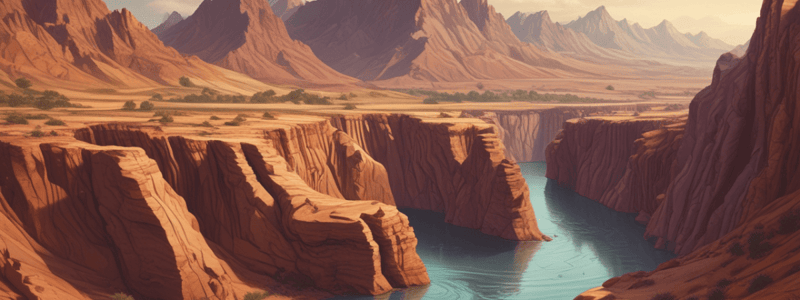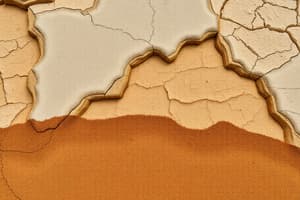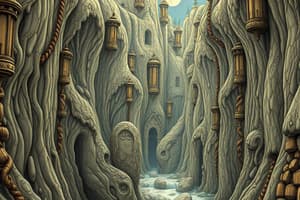Podcast
Questions and Answers
What happens to lower layers of sediment as new layers form?
What happens to lower layers of sediment as new layers form?
- They support the weight of the upper sediment layers (correct)
- They become denser
- They are pushed upwards
- They are eroded away
What determines the type of settling process in a given area?
What determines the type of settling process in a given area?
- The flow rate of the water
- The temperature of the environment
- The initial concentration of the sediments (correct)
- The size of the sediment particles
What is the sediment concentration during discrete settling?
What is the sediment concentration during discrete settling?
- Medium
- At its highest
- Variable
- At its lowest (correct)
What happens to the Mississippi River as it flows towards its oceanic destination?
What happens to the Mississippi River as it flows towards its oceanic destination?
Why does the Mississippi River create multiple channels?
Why does the Mississippi River create multiple channels?
What forms in the deltas of the Mississippi River during cold winter storms?
What forms in the deltas of the Mississippi River during cold winter storms?
What is characteristic of glacial moraines?
What is characteristic of glacial moraines?
What is the purpose of settling tanks in water treatment plants?
What is the purpose of settling tanks in water treatment plants?
What happens to solids in settling tanks?
What happens to solids in settling tanks?
What is added to the wastewater to facilitate the settling process?
What is added to the wastewater to facilitate the settling process?
What happens to sediment particles as they reach the flat coastal plains of Louisiana?
What happens to sediment particles as they reach the flat coastal plains of Louisiana?
What is the result of the sedimentation process in the Mississippi River delta?
What is the result of the sedimentation process in the Mississippi River delta?
What is characteristic of the sedimentation process in glacial moraines?
What is characteristic of the sedimentation process in glacial moraines?
What is the purpose of adding a coagulant in the water treatment process?
What is the purpose of adding a coagulant in the water treatment process?
What happens to the sediments as the glacier melts?
What happens to the sediments as the glacier melts?
What is the result of sedimentation in the context of water treatment?
What is the result of sedimentation in the context of water treatment?
What is the relationship between the type of settling process and the initial concentration of sediments?
What is the relationship between the type of settling process and the initial concentration of sediments?
What is a characteristic of discrete settling?
What is a characteristic of discrete settling?
What happens to the sediment particles during flocculent settling?
What happens to the sediment particles during flocculent settling?
What is the purpose of removing sludge from the settling tank?
What is the purpose of removing sludge from the settling tank?
Flashcards are hidden until you start studying
Study Notes
What is Sediment?
- Sediment is a solid material on the Earth's surface that can be moved and deposited in a new locality, either on land or in water.
- Erosion is a major source of sediment movement, where water, wind, and ice pick up sediment particles and transport them elsewhere.
Sources of Sediment
- Minerals, rocks, and decomposed animals and plants are the primary sources of sediment.
- These materials form horizontal layers called strata, which are compressed together through lithification, resulting in sedimentary rock.
Types of Sediment
- Clastic sediment: formed from grains or fragments of other rocks and minerals.
- Biogenic sediment: formed from the shells of marine organisms, which accumulate on the ocean floor.
- Chemical sediment: formed when ion-rich water evaporates, leaving behind dissolved ions, such as rock salt.
Classification of Sediment by Particle Size
- Geologists classify sedimentary rocks and clasts according to size, shape, and texture.
- Sizes range from boulder (>256 mm) to clay (<1/256 mm), with intermediate sizes including cobble, pebble, sand, silt, and gravel.
Sediment Formation Processes
- Weathering: breaks rocks and minerals into smaller fragments through physical or chemical means.
- Erosion: initiates the movement of sediment from one location to another through forces such as wind, water, and gravity.
- Sediment transport: the physical movement of sediment particles from one locality to another.
- Deposition: the process of sediment settling to the ground, also known as sedimentation.
- Lithification: the final step in sedimentation, where sediment layers are compressed, and moisture is expelled, resulting in sedimentary rock.
Types of Sedimentation
- Discrete settling: sediment particles settle to the earth's surface without coming into contact with another particle.
- Flocculent settling: sediment particles coalesce while falling to the ground.
- Zone settling: sediment particles fall to the ground at the same rate and as one complete unit.
- Compression settling: sediment particles are in contact with each other as they fall, with new layers supporting the weight of upper sediment layers.
Examples of Sedimentation
- The Mississippi River: carries sediments from Minnesota to the Gulf Coast of Mexico, depositing them in the coastal plains of Louisiana.
- Glacial moraines: formed as glaciers carve away at the land, pushing sediments into a ridge along one side of the ice wall or pooling at the foot of the glacier.
- Water treatment plants: rely on settling tanks to initiate the purification process of wastewater, where solids, including suspended sediments, settle to the tank's bottom.
What is Sediment?
- Sediment is a solid material on the Earth's surface that can be moved and deposited in a new locality, either on land or in water.
- Erosion is a major source of sediment movement, where water, wind, and ice pick up sediment particles and transport them elsewhere.
Sources of Sediment
- Minerals, rocks, and decomposed animals and plants are the primary sources of sediment.
- These materials form horizontal layers called strata, which are compressed together through lithification, resulting in sedimentary rock.
Types of Sediment
- Clastic sediment: formed from grains or fragments of other rocks and minerals.
- Biogenic sediment: formed from the shells of marine organisms, which accumulate on the ocean floor.
- Chemical sediment: formed when ion-rich water evaporates, leaving behind dissolved ions, such as rock salt.
Classification of Sediment by Particle Size
- Geologists classify sedimentary rocks and clasts according to size, shape, and texture.
- Sizes range from boulder (>256 mm) to clay (<1/256 mm), with intermediate sizes including cobble, pebble, sand, silt, and gravel.
Sediment Formation Processes
- Weathering: breaks rocks and minerals into smaller fragments through physical or chemical means.
- Erosion: initiates the movement of sediment from one location to another through forces such as wind, water, and gravity.
- Sediment transport: the physical movement of sediment particles from one locality to another.
- Deposition: the process of sediment settling to the ground, also known as sedimentation.
- Lithification: the final step in sedimentation, where sediment layers are compressed, and moisture is expelled, resulting in sedimentary rock.
Types of Sedimentation
- Discrete settling: sediment particles settle to the earth's surface without coming into contact with another particle.
- Flocculent settling: sediment particles coalesce while falling to the ground.
- Zone settling: sediment particles fall to the ground at the same rate and as one complete unit.
- Compression settling: sediment particles are in contact with each other as they fall, with new layers supporting the weight of upper sediment layers.
Examples of Sedimentation
- The Mississippi River: carries sediments from Minnesota to the Gulf Coast of Mexico, depositing them in the coastal plains of Louisiana.
- Glacial moraines: formed as glaciers carve away at the land, pushing sediments into a ridge along one side of the ice wall or pooling at the foot of the glacier.
- Water treatment plants: rely on settling tanks to initiate the purification process of wastewater, where solids, including suspended sediments, settle to the tank's bottom.
Studying That Suits You
Use AI to generate personalized quizzes and flashcards to suit your learning preferences.




